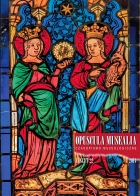Witraże z Grodźca. Część II.
Stained Glass Windows from Grodziec. Part II
Author(s): Elżbieta Gajewska-ProrokSubject(s): Museology & Heritage Studies, Library and Information Science
Published by: Wydawnictwo Uniwersytetu Jagiellońskiego
Keywords: medieval stained glasses; conservation; technology; National Museum in Wrocław; Jagiellonian University Museum Collegium Maius in Kraków
Summary/Abstract: Until 1945, the panels of stained glass windows representing Madonna and Child, Man of Sorrows (Vir Dolorum), Virgin Mary and the Angel Gabriel (Annunciation), the Apostles – Saint James the Greater and Saint Andrew, as well as the following Saints – Erasmus, Wolfgang, Nicholas, Leonard, Margaret and Barbara, stored within the collections ofThe National Museum in Wrocław and of the Jagiellonian University Museum in Kraków, constituted two groups of stained glass windows set in metal frames of ca. 235 x 177 cm.The group of 14 panels is stylistically quite consistent; it undoubtedly comes from one architectural unit, perhaps from the church in Oberwölz. The existence of small differences between the ways in which the faces were painted or the figures got built allows to distinguish two groups created around 1425 and around 1430. Comparing the style and the technique of the stained glass windows discussed indicates that they were produced in Austria in a workshop operating at the border of Upper Styria and Carinthia. The nearest analogies can be noticed in stained glass windows from the „Maria im Waasen” Church in Leoben, the Maria Höfl Church in Metnitztal, a church in Tamsweg and a church in Gaisberg. The stained glass windows from Grodziec were restored and slightly reshaped (by the addition of inscriptions and frames of rhombus-shaped glazing) in the 19th century and at the beginning of the 20th century. The conservation and restoration performed in the years 2000–2001, 2011 (Kraków panels of the stained glass windows from Grodziec) and 2013–2014 (Wrocław panels) consisted in cleansing the works of numerous layers and of instances of „cold” re-painting, as well as filling in extensive cavities in parts of the figures’ trunks. As far as the Wrocław stained glass win
Journal: Opuscula Musealia
- Issue Year: 2014
- Issue No: 22
- Page Range: 95-116
- Page Count: 22
- Language: Polish

